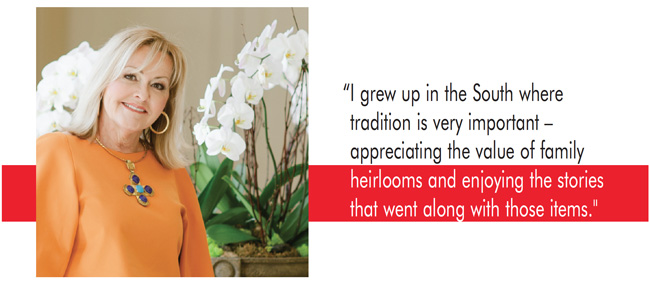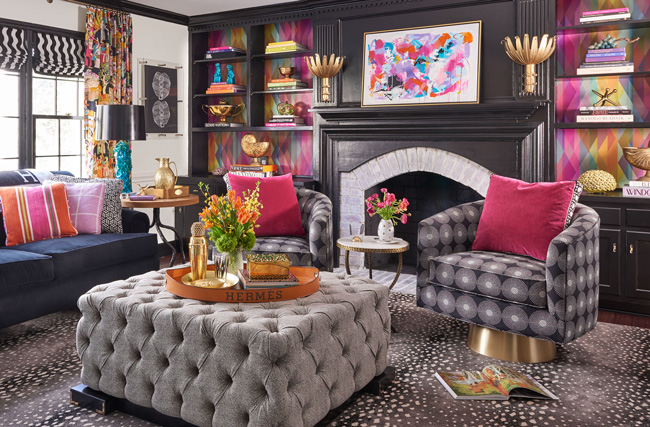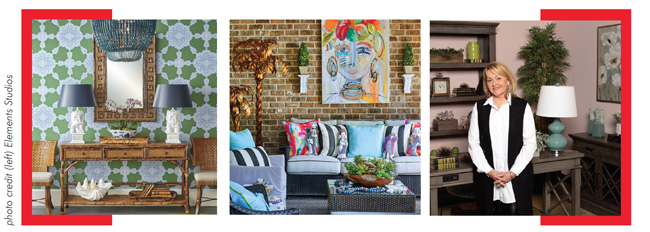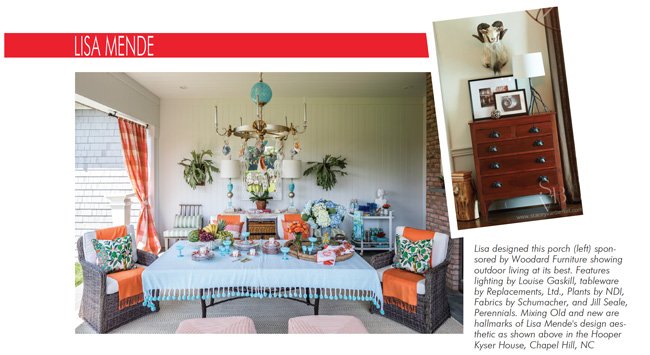
Interior designer, blogger, style spotter and influencer, Lisa Mende shares her perspectives on uniquely southern design, new trends and collaboration between retailers and designers.
Featured this month in Furniture World’s Design & Designer series, is Lisa Mende, the founder and principal of Lisa Mende Design. Lisa is acclaimed throughout the southeast for her interior designs that infuse traditional elements with a modern vibe. She maintains a lively social media presence through her blog, also named Lisa Mende Design. In addition to being an allied member of ASID, IDS, Design Trust of NYC and WithIt, she has been a High Point Market Style Spotter three times.
Starting out in Design
I grew up in Newton Grove in eastern North Carolina. My dream was to go to the big city to work in the fashion industry. Instead, I ended up living in a small town working for Roses Stores as a copywriter, because I couldn't find anything in my field, apparel design.
“After a few years, I found a job as a ladies’ clothing buyer for a five-store regional chain and managed two of the stores. When my first child was born, I no longer wanted the retail hours, so I got a job representing a clothing line in North and South Carolina. After that, I was a part-time marketing director for a nutritional company.”
Politics to Interior Design
“I also worked for the Clinton campaign, and then for a period at the White House. I returned home to reevaluate how to balance work and raising my children. I thought, ‘I should go back to school for interior design.’ So, I went to the University of North Carolina, Greensboro, met my present husband, moved to Charlotte, and transferred to an interior architecture program.
“In my junior year, I took an internship with a local kitchen and bath firm here in Charlotte and fell in love with the whole idea of doing residential design. In 1998, I opened my own practice and had a third child.”

Realignments
“In 2008, I was at a client’s house with fabrics spread all over the kitchen island when the husband returned home and said, ‘What are you doing here? Haven’t you heard? The market crashed.’ After that, luxury design was a hard business. Our business went from doing whatever we wanted without budget considerations, to minimal jobs to redesign houses without spending a fortune.
“A year later a client shared her story of losing a child to leukemia, and I told her there was no way I could survive that. Little did I know that the very next night I would be getting a call that my oldest child, Walker, a senior at Auburn, had been in a kayaking accident and was lost. I quit working cold turkey, stayed in my house, didn’t talk to people, didn’t do anything. My husband pretty much took over.”
Sisters in Design
“About two years after that, a friend suggested that I start a blog. And I asked, ‘What is a blog?’ So, I started blogging, initially having no idea what I was doing, or what it meant. Soon I connected with other bloggers, including interior designer Tobi Fairley, joining her Mastermind Group which did business consulting with designers.
“Once I reconnected with supportive people, I became re-energized. They became my sisters in design.
“Soon business picked up. I did a showhouse with Traditional Home magazine, and then went on to do seven national showhouses with them. Through my blog, I’ve met so many people; gone on domestic and international blog tours, worked with retailers, like Ballard Design, and have been asked to design national campaigns with companies like DXV by American Standard. I was a brand ambassador for ROHL Auth Lux Designer Guild, and am on Thermador's design council. I’ve also worked with Twin Star, Wesley Hall, Woodard Furniture, and Ballard Designs.
“Today, the majority of my blog’s readership is in major design cities like, New York, Atlanta, Los Angeles, and Dallas. I also have international readership. But it all started by connecting with Tobi, other designers, retailers, and manufacturers.”
Southern Style
|
“Sometimes I am
surprised by what stores offer and how they have it displayed; I feel they should have involved a designer for a more cohesive look.” |
“I grew up in the South where tradition is very important, appreciating the value of family heirlooms and enjoying the stories that went along with those items. As a southerner who grew up with that appreciation, my design is rooted in tradition. I’m comfortable around traditional pieces, love antiques and the history that goes with them.
“As I’ve become more seasoned as a designer, I’ve traveled and learned to appreciate other cultures, abstract art, and the mixing together of everything to create multiple layers in a room. These layers, along with items old and new, speak to a client’s personality. They tell a story and are the basis of creating interesting interiors.
“Although my interiors are rooted in tradition, I like to add new and fresh elements. I discover what’s special in a client’s life, give those pieces prominence and edit others out. On the other hand, I also appreciate maximal interiors. I’m known for creating livable luxury.”
Function and Beauty
“Beauty always follows function in my world. If something is beautiful, but doesn't function for the families or businesses I'm designing for, then my work is not successful. Once I have the floorplan in place, the room comes to life with fabrics, wallpapers, furniture, rugs, accessories, and art.”
Rethinking Wasted Space
“A lot of my clients aren't using their living rooms, which is a waste of space. Instead, they want big family rooms, designed for a more casual and comfortable lifestyle. That’s been a trend for the last ten years or more. Or, they may re-imagine unused living rooms as offices at the front of their homes.
“However, some people still love their dining rooms. Overall, however, dining room style has changed along with the current style of entertaining. But in the South, we still love china, sterling and crystal. Of course, it depends on the client.
"For furniture retailers, addressing wasted space in their customers' homes, can result in re-purposing those spaces and selling more furniture."
Working With Retailers
“I sometimes meet with clients who find out that they really do not have the budget to hire me. That’s an opportunity to direct them to a retail store that has in-house design services. This helps those clients get what they need while cutting their cost for extra design hours.
“Jason Harris at Furnitureland South has done a beautiful job of working with outside designers even though they have a large in-house design staff. When I’m looking for product, I can contact them to help me. I take clients there to sit on furniture. What a great way to work together in the industry.
“Retailers who don’t offer design services might reach out to independent designers, offering to help promote the designer’s brand in return for creating in-store vignettes. When customers come in, they see vignettes and find out that they can have their entire room designed with accessories, rugs, and art. I think it helps to sell more than just a sofa. Retailers may also want to consider giving greater discounts to designers beyond the small reductions that many currently offer.”
The Power of Story-telling
“There are so many furniture lines and so many ways that consumers can buy furnishings these days. That’s why retailers and manufacturers must tell better stories about the furniture and accessories they sell. How is the product made? What makes it stand out from all the others in terms of style and construction? What makes the sofa available down the street (or online) cost $1,000, while the one in your store is $6,000?
“One of the best ways to sell products is to emotionally connect the buyer to the product. When you learn about the people who have worked in a factory, such as Capel rugs, for their entire lives weaving braided rugs, it makes you appreciate buying that rug. The human connection is important to so many people. Every company should look for a way to share their stories so that the products, and the people behind those products are appreciated and valued. “This can create an emotional hook, helping customers or clients to feel a sense of ownership. For example, I just ordered a Thayer Coggin piece for a client. Of course, I explained the story of how it was designed by Milo Baughman for Thayer Coggin in the 1950s. If consumers are told something interesting about an item they are thinking of buying, they are more likely to purchase it, and when they get it home, it will mean more to them.”
Design Challenges
“As a designer, my biggest obstacle is making sure the products I specify are readily available. I cannot tell you how many times I specify something only to discover the item is on back order for six months which results in me going back to the drawing board for replacements.
“Another issue I deal with is damaged goods. The time spent dealing with returns reduces my bottom line. So, if I have a poor customer service experience with a company due to damage and returns, I tend to not buy from them again. On a positive note, I love to specify custom products and work with North Carolina companies to create something unique which provides custom interiors for my clients.
“Sometimes I am surprised by what stores offer and how they have it displayed; I feel they should have involved a designer for a more cohesive look. Often retailers just group furniture by brands without an idea about the display. More thoughtfully curated merchandising would sell more furniture – as well as rugs, accessories, and art. Those who do it well, benefit.
“On the other hand, when retailers focus too much on the ROI of individual pieces at the expense of an artfully edited selection, it creates a disconnect between the customer’s experience and outcome.”
|
“Jason Harris at Furnitureland South
has done a beautiful
job of working with
outside designers even though they
have a large in-house design staff.” |
Retail Inspiration
“Lots of times people don’t have the time or the means to travel to get the kind of perspective gained from visiting international markets and trade shows, such as Maison Objet in France, Heimtextil in Germany, Salone de Mobile in Italy, and London Design. These shows give us a peek into where things are going, as well as what new brands might be worthy of introduction in the U.S. If travel is not possible, read magazines, blogs, follow people on Instagram and Pinterest – see what both designers and consumers are posting.
“Visitors to High Point Market can also easily visit the Bienenstock Furniture Library in the heart of High Point. It has a vast collection of all different types of books that range from architecture to furniture history, art history, fabric design; everything and anything that you could think about in the world of furnishings design. When I visit, I feel like I'm in a magical place. It's inspiring to be able to touch the books – books are tactile – and designers want to feel things, we want to touch them. It's so much more inspiring than looking at them on a computer screen.
“Sister Parish said, ‘Innovation is often the ability to reach into the past and bring back what is good, what is beautiful, what is useful, what is lasting.’”

“The furniture industry
has been slow to incorporate technology. But furniture retailers can still address
smart home technology to let their customers know that they are cutting-edge. ”
Millennial Customers
“Some of my clients will say to me, ‘My children don't want my antiques, they don't want to inherit anything.’ This is a big trend right now. Younger consumers want to streamline their lives, live in smaller spaces with multi-purpose furniture, unencumbered.
"Higher-end furniture rental is on the rise in places like New York City. Millennials can get furniture, electronics, appliances, housewares, and decorative items delivered for a variable lease term. Then, if they move, get a job across country, or just want a change, the company picks it up and takes it back. There's no emotional tie to that furniture. They want it fast and they want it now, but they don’t want grandma's china cabinet!
“We have been spoiled, expect everything to be delivered next day, however, custom design isn't quick. Younger generations are often OK with sub-par quality in many respects if they can simply check something off their list by clicking 'buy now' online. The furniture industry has to move fast to provide in-stock options so we can all deliver quickly to our clients and compete.”
Trending
Sustainable: “It’s going to get more and more important as the population increases and resources become less available. In states like California, sustainable design is important now. The younger generation, especially, is very concerned about sustainability.”
Outdoor vs. Indoor: “The distinction between indoor and outdoor has become a blur. We are using outdoor furnishings inside now, and the designs for outdoors look more like interior rooms.”
Old and New: “Combining old and new makes a room what it needs to be for me. Every room should have something old and something new. It’s the layers that create great design.”
Bedroom Design: “Private spaces should be soft, soothing and inviting, with lots of beautiful textures that feel comfortable and relaxing.”
Dining Rooms: “Dining rooms are still important in the South. I feel beautiful spaces that make you feel special – with hand-painted murals and luxurious fabrics – are highly on trend.
Smart Homes: “Smart homes are becoming mainstream. People have realized that they can use home technology to make their lives easier.
“The furniture industry has been slow to incorporate technology. But furniture retailers can still address smart home technology to let their customers know that they are cutting-edge. Retailers could have an event or seminar about smart home technology and entice consumers to come into stores and think about creating beautiful and functional living areas.”
Other Trend Perspectives: “In January I visited the Heimtextil show in Frankfurt, Germany, the largest textile show in the world. One of the most interesting areas at the show was the Trend Space. Instead of thinking in terms of color trends, for instance, the show presented a number of trends being driven by the way people live.
“Five trends they identified were: Go Off-Grid, Pursue Play, Seek Sanctuary, Escape Reality, and Embrace Indulgence. For example, Go Off-Grid featured designs that incorporated or were based on outdoor textiles, work clothing, and had the utilitarian aesthetics of functionality and durability. The idea was that people are tired of being connected all the time, so they're shutting down and they're going off the grid, camping, getting back to nature, or just disconnecting.
“The Pursue Play trend was identified as a reaction to the stress people are feeling from today’s political situation and uncertainty, including environmental problems. Playful activities that help us escape and be optimistic are an antidote to being inundated. The exhibit featured bold designs, humor, and interesting tactile materials.
“The trends addressed the way we live, using colors and patterns that support various lifestyles. Trendy colors and patterns don’t pop up out of nowhere; they are actually connected to the way we live and breathe. When you think of trends in this way, you realize that the things we do as designers or retailers are important to the health and welfare of our clients.”

Not Trending
“My blog has a ‘never-in-style’ section – here are a few examples. Nail heads are not in style. Nail heads are forever. They’ve been around since furniture was first designed, and will always be popular. But, in the last few years, people have overdone nail heads. I’ve seen rooms with nail heads on the table, nail heads on the chairs, and on the sofa.
“Another one is granite, which has been very popular over the past few years. People are always asking me if granite is in style anymore. It's a natural stone, timeless and will always be here. So, I don't think of it as trendy.
“Navy and grey have been popular over the last 10 years. They are now considered neutrals and will be a mainstay of our palette. They are not on trend anymore, but they're not out of style.”
Partnering With Influencers
“The market considers me an influencer. “When choosing who to work with influencers, retailers and manufacturers need to be careful, because there is a lot of fake social media out there. It’s important to vet influencers before partnering with them. Just because somebody has a million followers it isn’t a guarantee that reaching out to those followers will produce a desired outcome.
|
“When you think of trends in this way, you realize that the things we do as designers or retailers are important to the health and welfare of
our clients.” |
"Fortunately, it’s not that hard to figure out if an influencer is reaching a brand’s ideal customers. They can read followers’ comments and see if they are representative of the type of market the brand is trying to reach.
“Here’s the challenge for retailers, manufacturers and designers: if they want their brands to be considered authorities on design, they need to work harder at building a tribe of people who trust them. Market research shows that people buy from people they like and trust.”
Retail Growth Opportunity
“When I worked in retail, I gained a respect for retailers, and the competitive aspects of buying and selling. There are a lot of ways designers and retailers can work together to support one another and solidify our connections to one another through collaboration."

Russell Bienenstock is Editor-in-Chief of Furniture World Magazine, founded 1870. Comments can be directed to him at editor@furninfo.com.